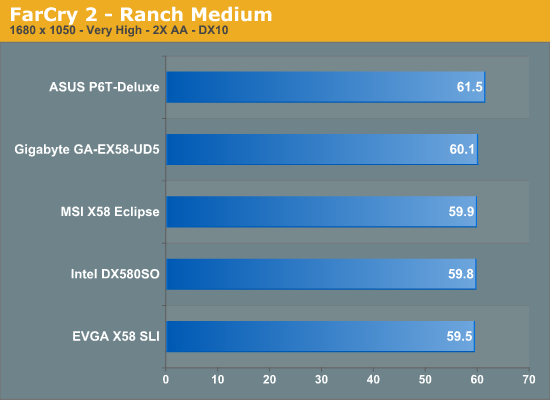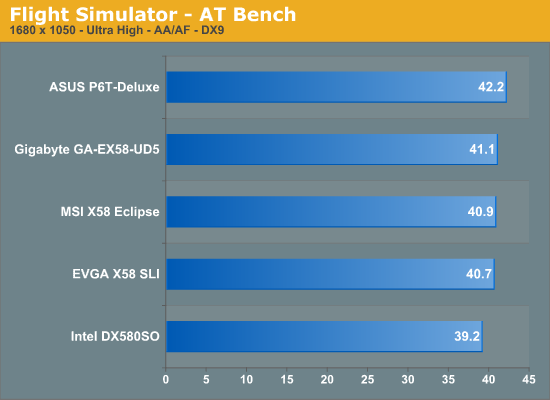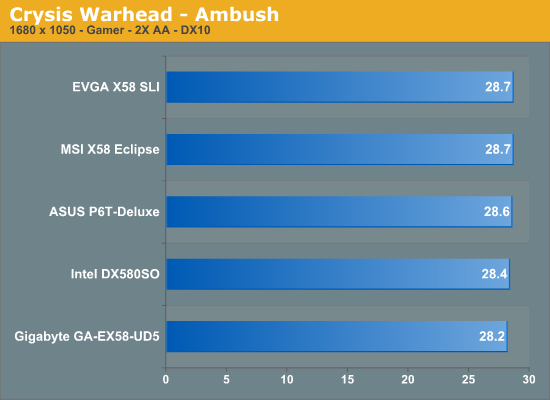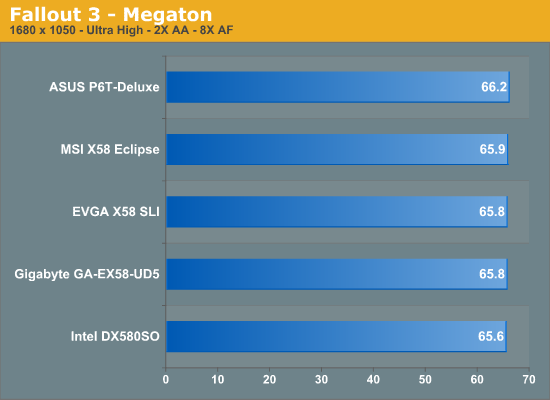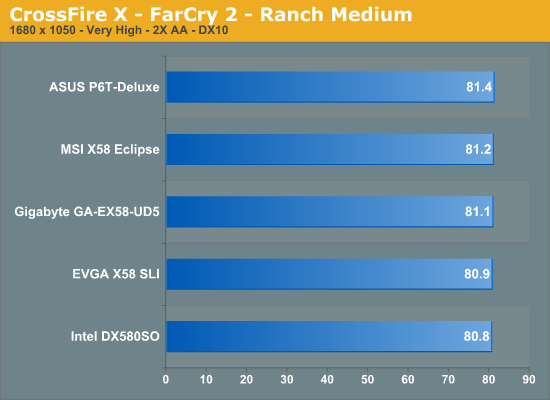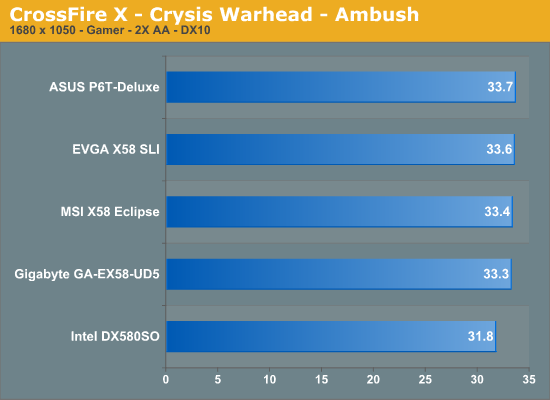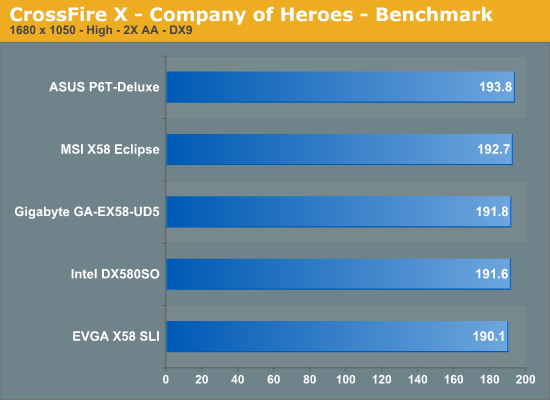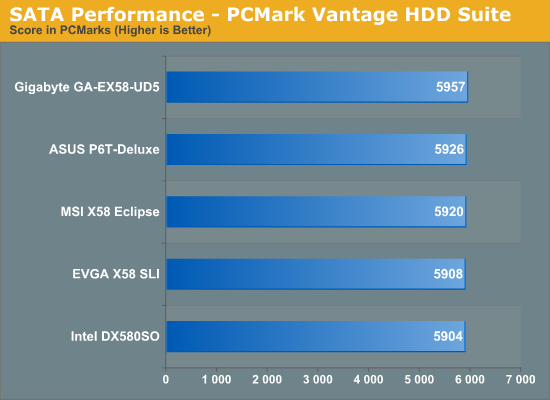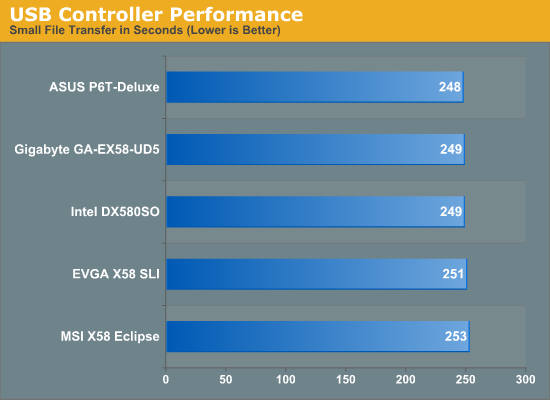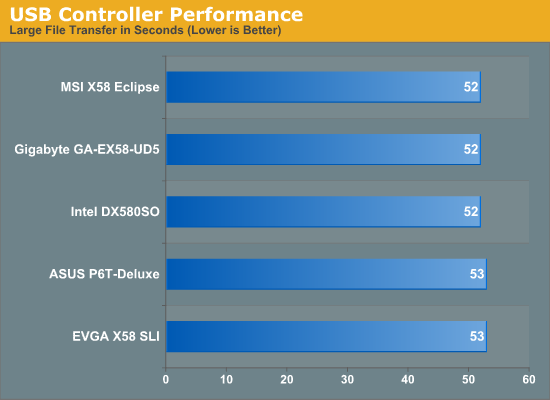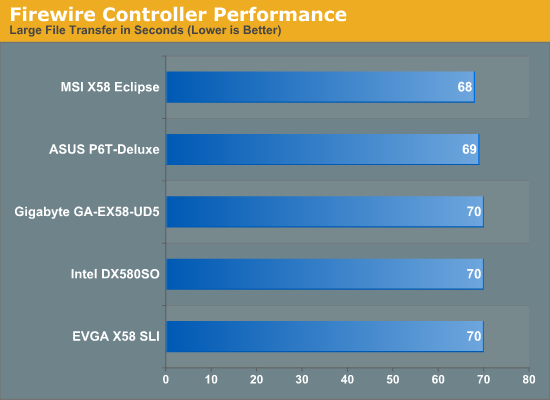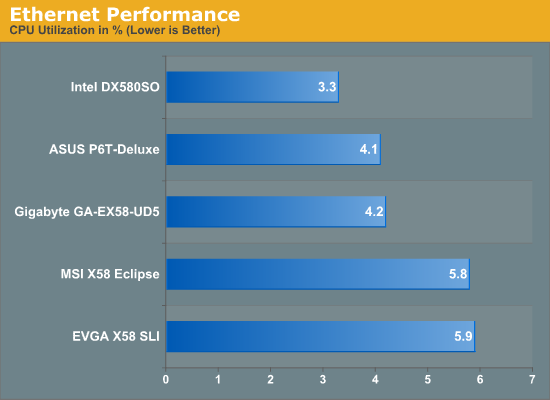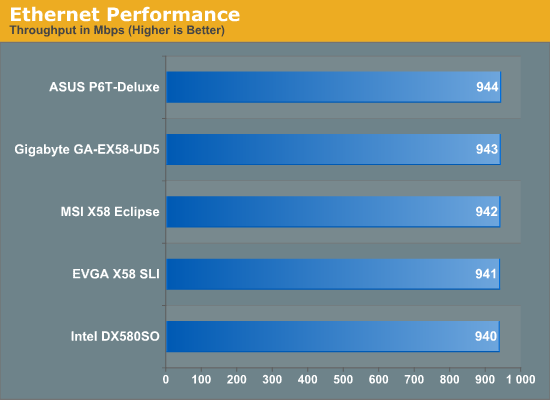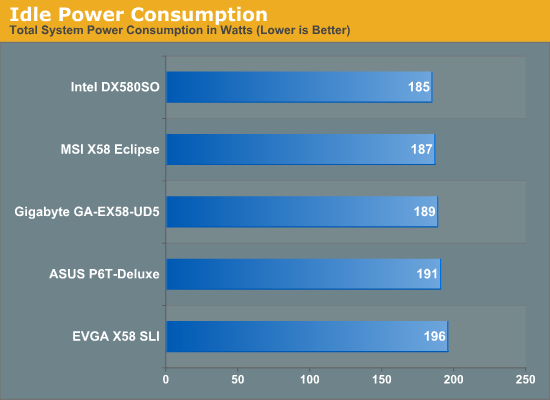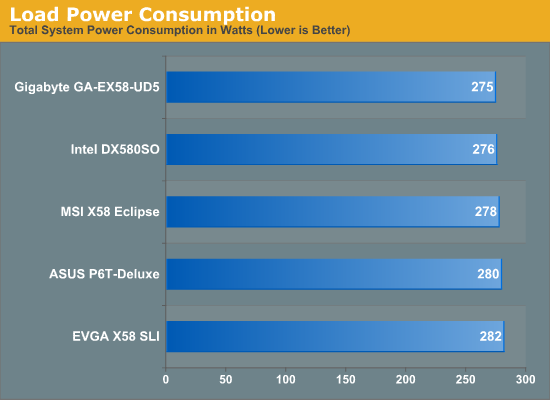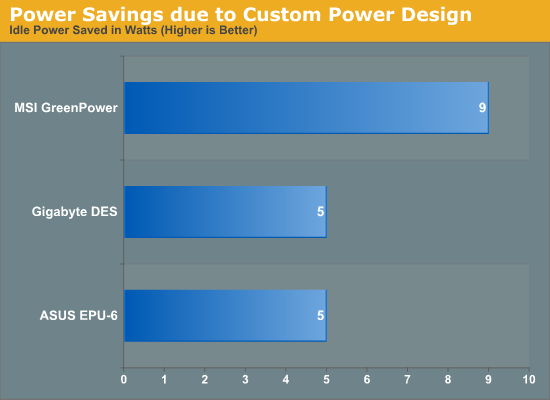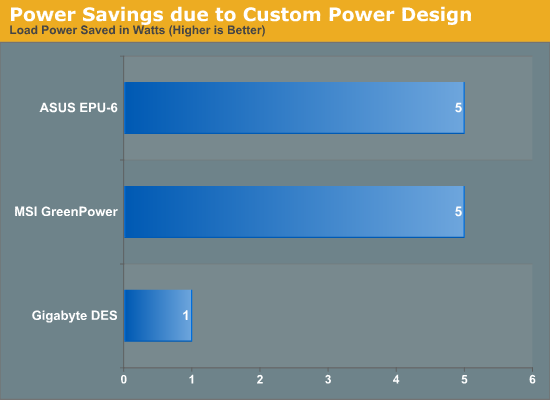Initial Overclocking Results
We are working on a comprehensive overclocking guide for the i7/X58 platform to fully explain each BIOS setting as well as providing an easy to follow set of instructions to get the most out of this new platform. In the meantime, we are showing our initial overclocking results with air-cooling and the i920. To be blunt, overclocking the i920 on air to 4GHz is fairly simple: raise Bclk to 191, enable turbo and HT modes, set VCore to 1.4125V, VTT to 1.30V, VDimm to 1.67V, and set your 6GB kit to 9-9-9-24 as a good base start. After that, it is merely a matter of fine tuning the voltages a little and adjusting memory timings for improved performance and/or stability. Of course, all of this depends on the quality of your memory, cooling, and CPU. In our case, even with very good air-cooling, we found the practical limit for VCore to be around 1.425V without incurring throttling under load temperatures. Based on this setting, we arrived at our 21x191 setting. We will take a further look at overclocking on these boards and others with a CoolIT Systems Freezone Elite shortly.
Our overclocking numbers are reached with HT and Turbo settings enabled on a retail CPU. This adds a significant load on the IMC and memory system resulting in the need to run higher voltages than if we turned off HT or Turbo, especially HT. In fact, a 19x211 (ES CPU) setting without HT or Turbo enabled resulted in us lowering VCore from the 1.4125V range to 1.35V and VDimm from an average of 1.67V to 1.64V while retaining like CPU clock speeds and stability. Performance is basically equal, except in applications that take advantage of four or more cores where a slight lead goes to an HT enabled system. Our retail CPU sample is not the best around so our non HT/Turbo enabled voltages and Bclk numbers could be improved with a better unit. In fact, the retail CPU we utilized refused to go over a 205 Bclk so we had to use an ES sample for the 19x211 testing. We have additional CPUs arriving shortly.
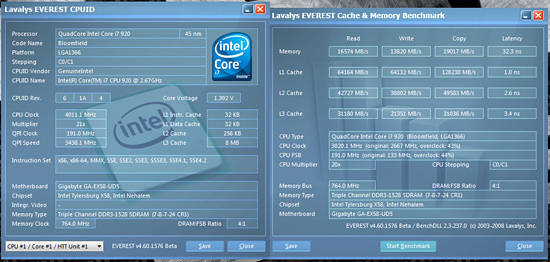
All of our boards easily reached 21x191 for a turbo boosted speed of 4010MHz or so. Each board was able to run our Corsair or Mushkin 1600MHz 6GB kits at CAS7 with ASUS offering the best timings at 7-7-7-20 1T, Gigabyte at 7-8-7-24 1T, MSI at 7-8-7-20 1T, and EVGA at 7-8-7-20 1T. Memory performance was very close for each solution considering the Bclk ratio was not exactly at 191 as set in the BIOS. The EVGA board returned a 190.5 setting, MSI at 191.5, ASUS at 190.9, and Gigabyte at 191. Even accounting for the various Bclk speeds, the boards were extremely close in the write, copy, and latency numbers; the exact numbers we think are extremely important for improving system performance with an IMC design, whether from Intel or AMD.
Overall, we think the Gigabyte numbers are the best and for good reason. On each board, we set the basic timings based on extensive stability testing and let each individual board set the balance of the subtimings based on their auto settings. Gigabyte offers an additional memory setting that improves subtimings automatically; there are three different settings: Standard, Turbo,and Extreme. We utilized the Turbo setting without affecting stability. The Standard setting returned results that were slightly lower than the other boards and the Extreme setting was not stable.
This is not to take away from the performance of the other boards. In fact, each successive MSI BIOS has improved memory performance and stability greatly, to the point now that the Eclipse board is able to run with the wolves. ASUS started out with the fastest memory performance, and in our initial testing beyond 4GHz their ability to run tighter timings pays off as you increase Bclk rates. EVGA just provided a BIOS that opens up 24 different subtimings and we could improve memory performance about 3% after a quick session.
Of course, manually tuning each setting certainly results in better performance in certain benchmarks - you know, the ones like SuperPI 32M, AquaMark, or WinRAR. However, you will never notice the difference in daily usage unless you do it wrong and wonder why Excel or Crysis constantly crashes. So, for the majority of users we highly recommend auto settings for the subtimings - and often for the base memory timings as well.
The one knock we have against the Gigabyte board is that VDroop is present even with load line calibration enabled. We had to set our VCore to 1.4250 to 1.4300V to ensure stability after accounting for VDroop; however, the board proved to be stable at a real 1.392V ~ 1.412V. The EVGA board tended to overvolt slightly under load while the MSI and ASUS boards kept VCore stable.
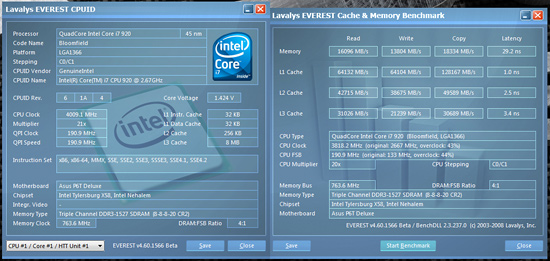
Overclocking to 21x191 with our G.Skill or Patriot 1600MHz kits was like an Indiana Jones adventure. Just when we thought the treasure of stability was in our hands, it would slip away quickly and we had to go through some exciting travels to get it back. To be honest, the ASUS board was the easiest to clock high with 12GB installed. The Gigabyte and EVGA products required a few BIOS revisions before we could overclock properly and we are still fighting with the MSI board. All of the manufacturers stated that they fully support 12GB operation up to DDR3-1333, but after that, the IMC is being pushed beyond its official rating from Intel. However, like the official 1.65V VDimm warning, we basically ignored the official rating and set off to see how high we could go on air-cooling.
Let's get the bad news out of the way first. We could not get the MSI board stable past a 21x175 setting utilizing manual tuning methods. We tried every setting, especially setting tRFC to 74 or higher and starting with 10-10-10-24 timings, but nothing worked. If we set the board to auto settings for voltages and memory, manually set Bclk to 200, and turned on Turbo/HT the board would work; however, VCore was set to 1.48V, VTT to 1.48V, and VDimm to 1.90V. Not bad for a stable 4.1GHz, and considering the relationship between VTT and VDimm, we were within a safe range for not destroying our CPU. However, the VCore level was too much for our air-cooling solution on a 24/7 basis and after a few hours load temps would rise past 90C, throttling would occur, and our system would crash. What we found to be strange was that a 21x191 manual setting, but with all other settings the same as the 21x200 setup, would crash the system after the initial POST sequence. MSI is working on it and we expect a solution shortly.
We were able to run the ASUS board at memory timings of 8-8-8-20 2T compared to 9-8-8-24 1T on the Gigabyte and EVGA boards. Memory performance was nearly identical between each board and once again showed that we could make a choice if required between a lower CAS setting with 2T or a higher CAS setting with 1T enabled without really affecting performance in our application benchmarks. We had to set VCore to 1.425V, VTT to 1.325V, IOH to 1.20V, and VDimm to 1.70V for 24/7 stability on each board. Once again, the Gigabyte board operated fine even though VDroop meant real voltage swung between 1.392V and 1.412V. We could have slightly reduced our VCore settings to 1.4125V on the ASUS and EVGA board but we always had Crysis Warhead lock up on us after the 15th pass out of 25.
Overall, we generally found it was easier to overclock with the ASUS P6T-Deluxe and could easily do it on mostly auto settings. We would recommend this board for those who do not want to get their hands too dirty to reach a reasonable overclock level. The ASUS BIOS is very informative and lists out the min/max and standard settings for the major BIOS options, and a new user interested in overclocking will find this comforting. You can still get down and dirty with the P6T when it comes to tweaking the BIOS for best performance. Based on this we find the ASUS board to have a very balanced design for both types of users.
Except for the informative BIOS settings, the same basically holds true for the EVGA X58 SLI board, and in some ways we liked its simplicity of settings when overclocking. The latest BIOS allows you to tweak further but still not to the absolute degree of the ASUS or Gigabyte boards. Since the V15 BIOS, getting high Bclk with 12GB has been relatively easy and pain free. Also, the BIOS is smart about setting the right auto timings to get the best possible performance while retaining stability. This platform has also proved to be rock stable. Depending on your memory supplier, there might be a need to set tRFC to 74 or higher when clocking high with 12GB installed.
The MSI Eclipse X58 is an interesting board; it has all the makings of a great overclocking platform and yet the BIOS is still a tweak or two away from being really good. The board performed equally to the other offerings with a 3GB or 6GB memory load but buckled underneath the pressure when loaded with 12GB. Based on the progress MSI has made in the past couple of weeks, we expect this problem to be solved shortly. The one item of note when overclocking this board is that a few of the voltage settings in the BIOS are rather cryptic as MSI utilizes a +/- setting for changes. The base voltage information is not always listed so the user has to have prior knowledge of base settings before making an informed decision.
The Gigabyte GA-EX58-UD5 is a tweaker's delight, and based on our initial testing with the latest F4K series BIOS we have no doubt now about the potential capabilities it offers. Gigabyte has come a long a way in improving the overclocking capabilities of this board along with improved performance and stability in a short time. If Gigabyte could match usability features of the ASUS BIOS and improve auto settings, we feel like this board could ultimately offer the best overclocking experience in the mid-range X58 market.
Final Words
All of our motherboards performed admirably today, some better than others, but in the end any motherboard sporting an X58 will perform the same when it comes to standard performance attributes. Which board is better really comes down to your needs, budget, and for some, product brand loyalty. We are willing to recommend any of our boards at this point in time.
The BIOS releases we utilized are stable now, offer excellent performance, and have addressed the majority of our usability problems. That said, each manufacturer still has tuning work left to accomplish for improved memory and overclocking performance. We might even see some minor improvements in power consumption shortly although our numbers reflect an almost best case scenario right now.
We still have several boards to review, ranging from the $220 MSI Platinum up to the $400 Foxconn Bloodrage with several in-between. Our next review will focus on the "lower" end X58 boards from Intel, Gigabyte, Biostar, and MSI. Our final review will feature the upper end boards from ASUS, Gigabyte, DFI, and Foxconn. In between, we will provide a comprehensive OC guide along with a detailed look at memory performance with several DDR3 tri-channel kits from Corsair, OCZ, Patriot, GSkill, Kingston, Crucial, and Mushkin. Look for these in the coming weeks after we return from our final IGP roundup.
So, let's just dive straight into our board recap. Additional details about each motherboard can be located in the features section.
Awards

We are proud to present the ASUS P6T-Deluxe with our Gold Editors Award. We highly recommend this board for beginners and advanced users alike. The Deluxe is not perfect, no board is, but it was by far the easiest board to use on a daily basis. Regardless of whether we wanted to setup a stable 24/7 folding machine or push the board to its limits trying to reach a new overclock record in the labs, it was a simple process to do either. We especially liked the ASUS BIOS as it is very informative, lists out the min/max and standard settings for the major BIOS options, and makes it possible for new users to quickly get the most out of the board. Yet, it still retains enough options to satisfy most tweakers and always recovered from settings that made us look for the clear CMOS button on the other boards.
When it comes to performance, the word balanced was the first thought in our minds. The P6T Deluxe offers the best video performance of the boards we tested while providing class leading performance in the majority of our application benchmarks. The board also features an array of options including Serial Attached SCSI controller support, SLI and CrossFire, very good on-board audio capabilities, eSATA and Firewire, and enough USB ports to make one forget about needing a hub. Based on the layout, this is the board we would recommend for 2x SLI or CrossFire users, plus you get the bonus of class leading video performance.

We are excited to present our Silver Editors award to Gigabyte for the GA-EX58-UD5. What else can we say, this board is a tweaker's delight and has tremendous performance potential. Based on the progress that Gigabyte has made with the latest F4K BIOS, we feel like this board could ultimately offer the best overclocking experience in the mid-range X58 market. The performance of this board was consistently near the top and ultimately offered the best overall memory performance. While performance is important, ultimately a board needs to offer the right feature set, stability, support, and pricing in a very competitive market.
The GA-EX58-UD5 offers all of this and more to potential X58 buyers. The UD5 offers an abundance of SATA ports, flexible layout, an excellent cooling solution, very good HD audio featuring Dolby Digital Live encoding, and an extensive accessory package along with excellent documentation.
We almost placed this board ahead of the ASUS P6T-Deluxe. There were just a few items that we felt like Gigabyte could improve upon to reach the next level. We wish Gigabyte could match the usability and informational features of the ASUS BIOS, the x16 slots are spaced too close to each other for our liking when using a 2x CrossFire or SLI setup since heat generation could be a problem in cases without proper ventilation, and losing the first DIMM slot when utilizing large CPU heatsink/fan designs means 12GB users are out in the cold. Regardless, the GA-EX58-UD5 is still an excellent board and one we highly recommend.
The Others
The
MSI Eclipse X58 is the most expensive board in the roundup at $322 with rebate and offers an extensive set of features and accessories. We loved the layout, color scheme, and overall quality of the board. We like to think of the MSI Eclipse as a Grand Touring Coupe in the automotive world, it offers an excellent blend of features and performance. The board performed equally to the other offerings with a 3GB or 6GB memory load but buckled underneath the pressure when overclocking with 12GB. Based on the progress MSI has made in the past couple of weeks, we expect this problem to be solved shortly.
We are not crazy about the BIOS layout as several of the voltage settings in the BIOS are rather cryptic since MSI utilizes a +/- setting for changes. The base voltage information is not always listed so the user has to have prior knowledge of base settings before making an informed decision when overclocking. MSI tries to make up for this with auto settings that almost allow the user to overclock exclusively by just setting the Bclk rate and letting the board do the rest. However, while this system worked well, it sometimes drove voltages past the rate we could effectively utilize with air cooling.
In the end, we still recommend the MSI Eclipse X58 for users who want a feature rich, stable, and well supported platform but do not plan on tweaking or heavily overclocking the system. This could all change with another BIOS update and we will be the first to let you know if it does.
The
EVGA X58 SLI is an excellent motherboard and one that we have throughly enjoyed working with the past few weeks. EVGA's support has been phenomenal and we expect that to continue to end users. This board has award worthy status written all over it, just one snag, memory multipliers. Unlike the other boards in our roundup and in the labs, the EVGA board tops out at a 10x memory multiplier (DDR3-1333) for the i965. Even though 10x is available, the i920/i940 are regulated to the 6x (800) or 8x (1066) multipliers. While we can live with these multipliers when raising Bclk to the 200+ level, we just find it a hindrance that the other multipliers are not available in a board designed for the more extreme users.
Otherwise, the quality of components, layout, and BIOS design are very good. Performance is also very good and in off-line testing it comes extremely close to the Gigabyte board up high. We have seen continual performance improvements and expect this board to do very well in the overclocking market once the memory multiplier problem is solved. If overclocking is not of primary importance, for a lot of us it is not, then the ease of use, stability, support, and features of this board make it a highly desirable product in the $300 range. At the end of the day, this board simply performs well and never makes a fuss about doing it.
AnandTech







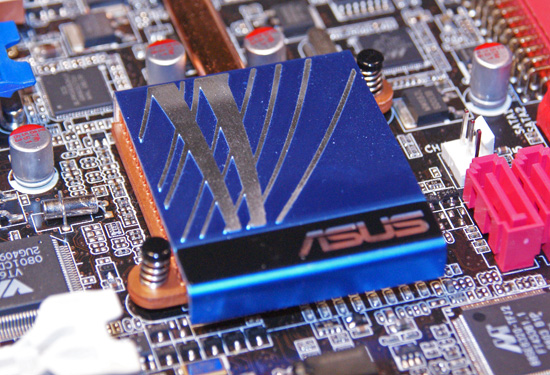
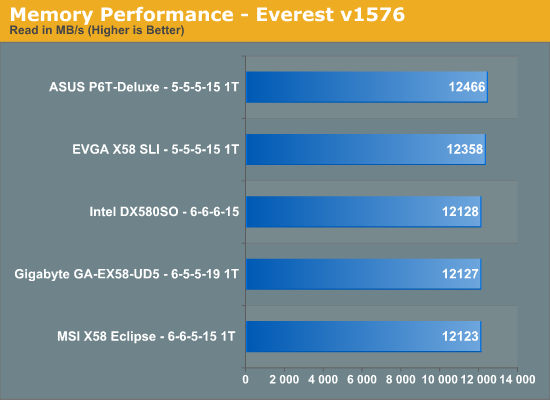
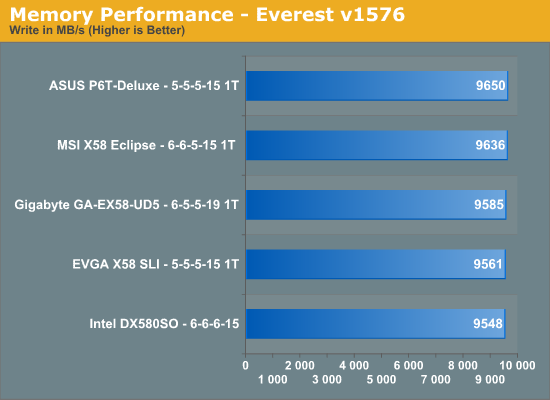
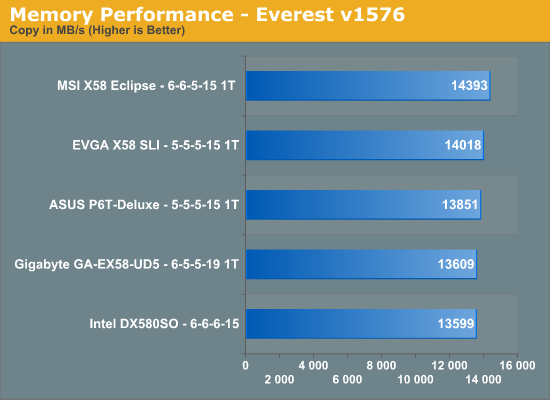
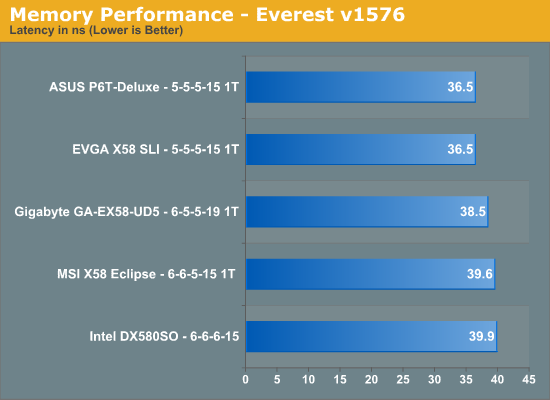
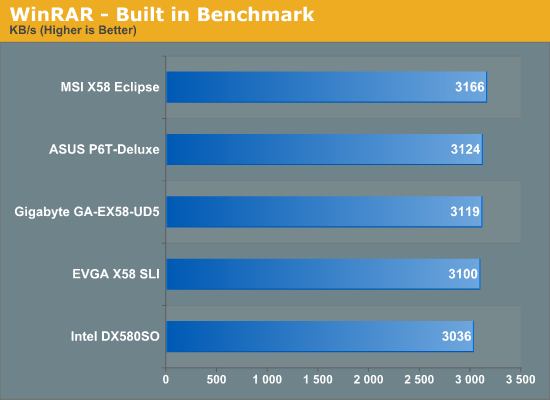
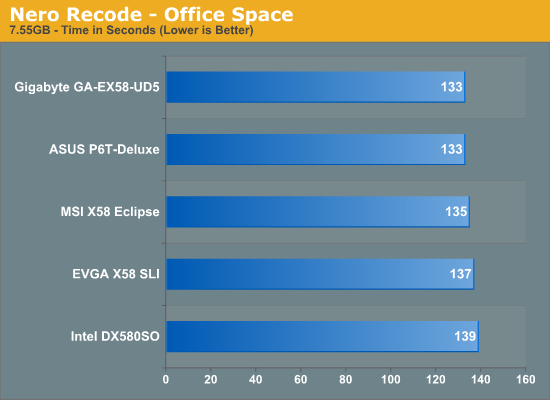
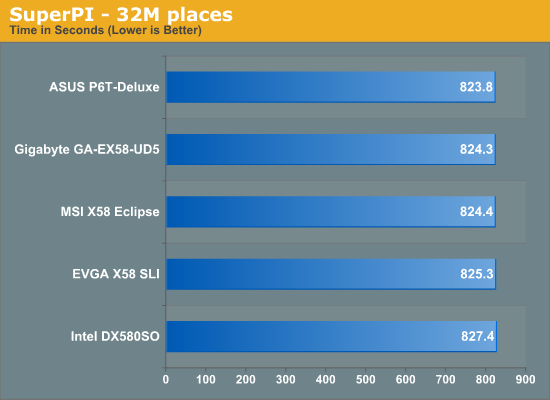
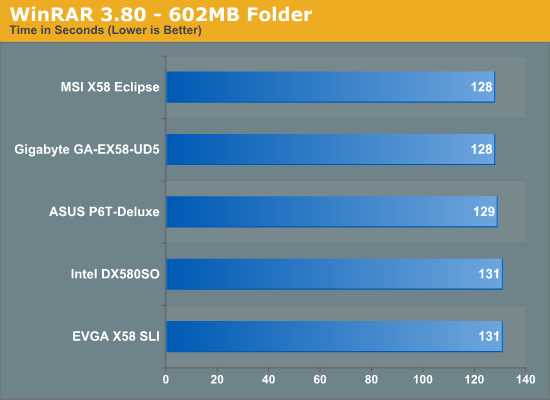
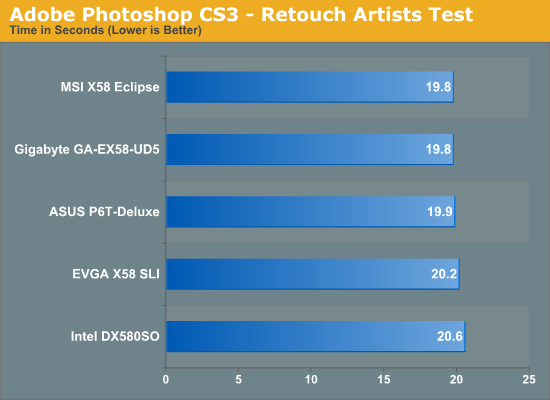
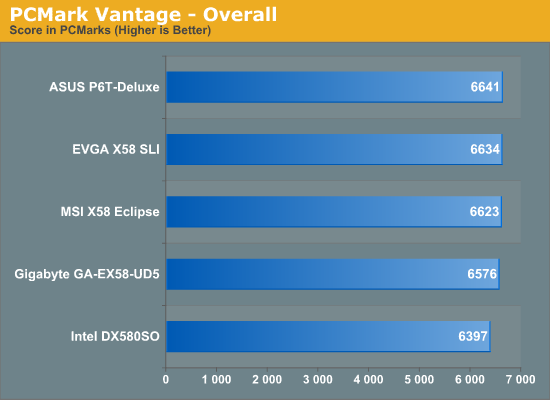
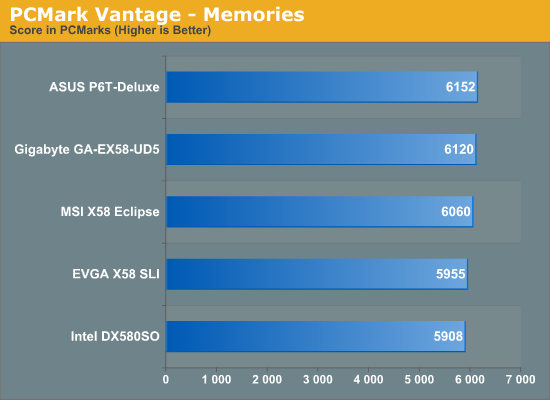
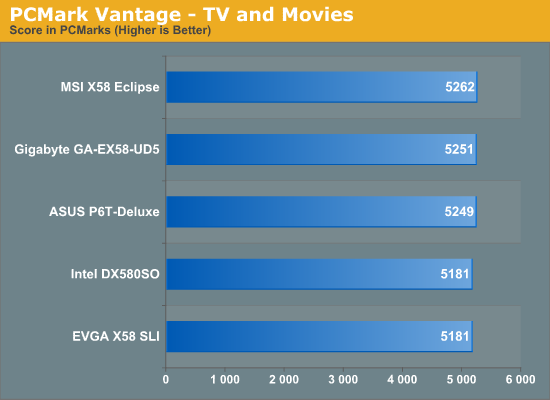
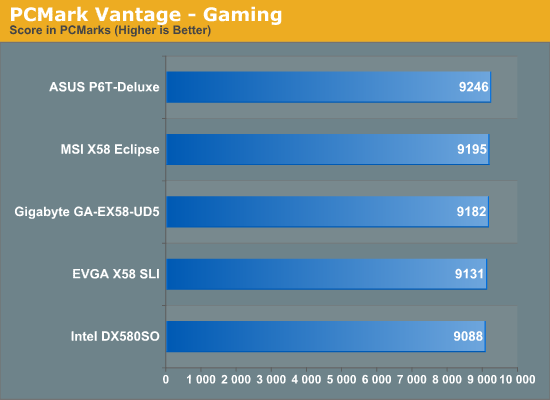
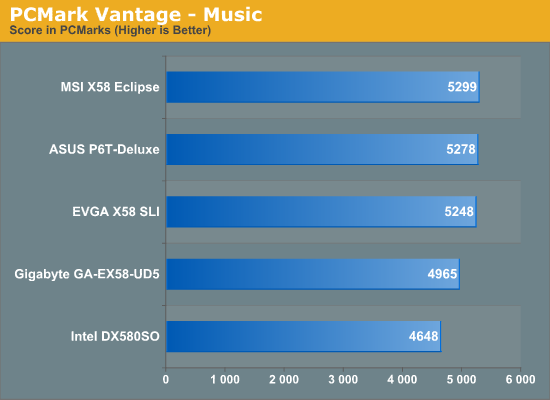
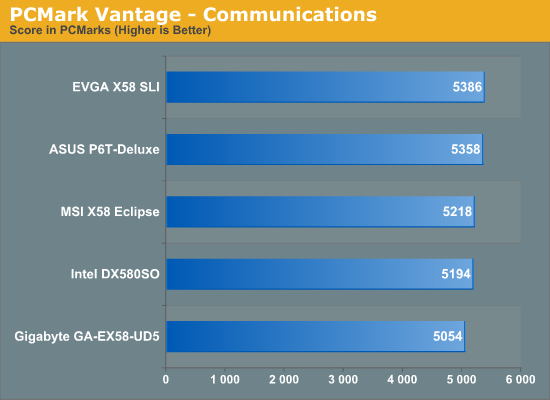
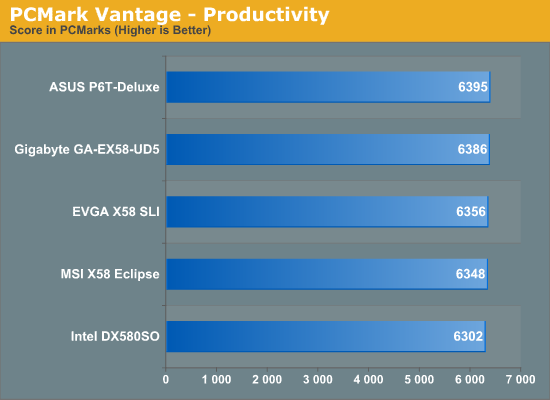



 Rispondi quotando
Rispondi quotando